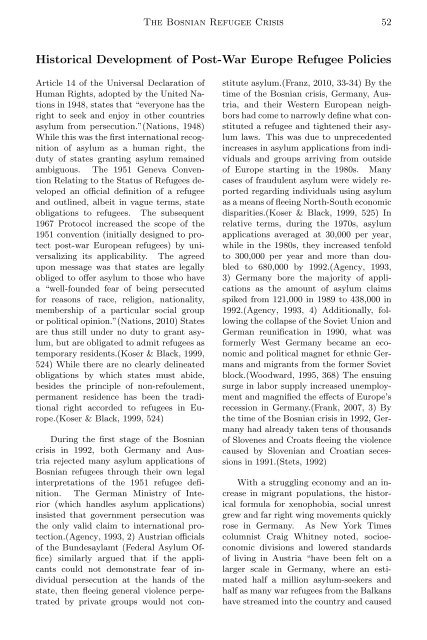You also want an ePaper? Increase the reach of your titles
YUMPU automatically turns print PDFs into web optimized ePapers that Google loves.
The Bosnian Refugee Crisis 52<br />
Historical Development of Post-War Europe Refugee Policies<br />
Article 14 of the Universal Declaration of<br />
Human Rights, adopted by the United Nations<br />
in 1948, states that “everyone has the<br />
right to seek and enjoy in other countries<br />
asylum from persecution.”(Nations, 1948)<br />
While this was the first international recognition<br />
of asylum as a human right, the<br />
duty of states granting asylum remained<br />
ambiguous. The 1951 Geneva Convention<br />
Relating to the Status of Refugees developed<br />
an o cial definition of a refugee<br />
and outlined, albeit in vague terms, state<br />
obligations to refugees. The subsequent<br />
1967 Protocol increased the scope of the<br />
1951 convention (initially designed to protect<br />
post-war European refugees) by universalizing<br />
its applicability. The agreed<br />
upon message was that states are legally<br />
obliged to o↵er asylum to those who have<br />
a “well-founded fear of being persecuted<br />
for reasons of race, religion, nationality,<br />
membership of a particular social group<br />
or political opinion.”(Nations, 2010) States<br />
are thus still under no duty to grant asylum,<br />
but are obligated to admit refugees as<br />
temporary residents.(Koser & Black, 1999,<br />
524) While there are no clearly delineated<br />
obligations by which states must abide,<br />
besides the principle of non-refoulement,<br />
permanent residence has been the traditional<br />
right accorded to refugees in Europe.(Koser<br />
& Black, 1999, 524)<br />
During the first stage of the Bosnian<br />
crisis in 1992, both Germany and Austria<br />
rejected many asylum applications of<br />
Bosnian refugees through their own legal<br />
interpretations of the 1951 refugee definition.<br />
The German Ministry of Interior<br />
(which handles asylum applications)<br />
insisted that government persecution was<br />
the only valid claim to international protection.(Agency,<br />
1993, 2) Austrian o cials<br />
of the Bundesaylamt (Federal Asylum Office)<br />
similarly argued that if the applicants<br />
could not demonstrate fear of individual<br />
persecution at the hands of the<br />
state, then fleeing general violence perpetrated<br />
by private groups would not constitute<br />
asylum.(Franz, 2010, 33-34) By the<br />
time of the Bosnian crisis, Germany, Austria,<br />
and their Western European neighbors<br />
had come to narrowly define what constituted<br />
a refugee and tightened their asylum<br />
laws. This was due to unprecedented<br />
increases in asylum applications from individuals<br />
and groups arriving from outside<br />
of Europe starting in the 1980s. Many<br />
cases of fraudulent asylum were widely reported<br />
regarding individuals using asylum<br />
as a means of fleeing North-South economic<br />
disparities.(Koser & Black, 1999, 525) In<br />
relative terms, during the 1970s, asylum<br />
applications averaged at 30,000 per year,<br />
while in the 1980s, they increased tenfold<br />
to 300,000 per year and more than doubled<br />
to 680,000 by 1992.(Agency, 1993,<br />
3) Germany bore the majority of applications<br />
as the amount of asylum claims<br />
spiked from 121,000 in 1989 to 438,000 in<br />
1992.(Agency, 1993, 4) Additionally, following<br />
the collapse of the Soviet Union and<br />
German reunification in 1990, what was<br />
formerly West Germany became an economic<br />
and political magnet for ethnic Germans<br />
and migrants from the former Soviet<br />
block.(Woodward, 1995, 368) The ensuing<br />
surge in labor supply increased unemployment<br />
and magnified the e↵ects of Europe’s<br />
recession in Germany.(Frank, 2007, 3) By<br />
the time of the Bosnian crisis in 1992, Germany<br />
had already taken tens of thousands<br />
of Slovenes and Croats fleeing the violence<br />
caused by Slovenian and Croatian secessions<br />
in 1991.(Stets, 1992)<br />
With a struggling economy and an increase<br />
in migrant populations, the historical<br />
formula for xenophobia, social unrest<br />
grew and far right wing movements quickly<br />
rose in Germany. As New York Times<br />
columnist Craig Whitney noted, socioeconomic<br />
divisions and lowered standards<br />
of living in Austria “have been felt on a<br />
larger scale in Germany, where an estimated<br />
half a million asylum-seekers and<br />
half as many war refugees from the Balkans<br />
have streamed into the country and caused


